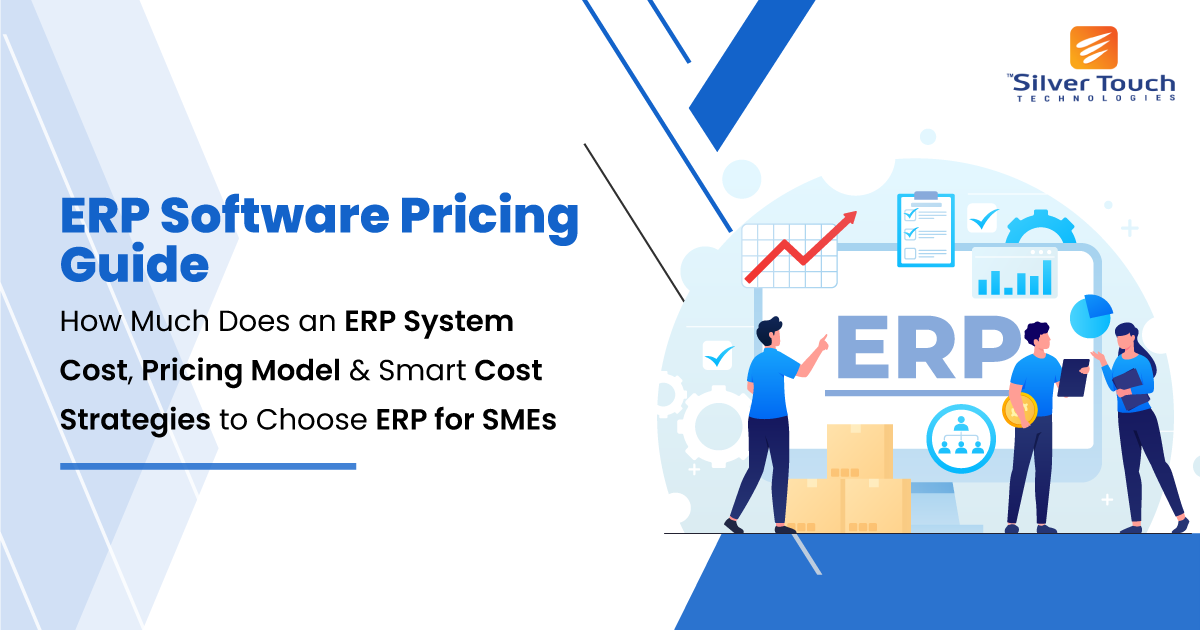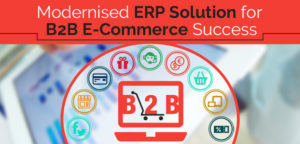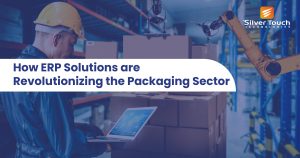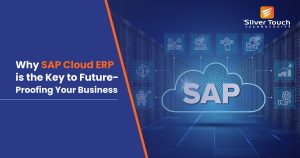The aim of an ERP software implementation is to increase efficiency of business processes and significantly reduce operating costs. That is why it is very much important for the businesses to have a complete ERP software pricing guide so that they can take the right decision. .
Below is the ERP software pricing guide to follow in the early phase of implementation with which you can minimize and control your overall cost of ownership, more effectively manage your business resources and increase the return on your investment.
With todays business climate with uncertainty over exchange rates, you need to future proof your company and provide a solid, reliable platform for growth.
What is an ERP?
ERP stands for enterprise resource planning, but what is the definition? ERP system is to help the core business processes needed like finance, HR, manufacturing, supply chain, and others to run a company. At the basic level, ERP software helps to efficiently manage an integrated system as a record of the entire system.
Even though today, ERP systems are basic and a little similar to the ERP decades ago. Today the system is integrated with the cloud and latest technologies like AI/ML to provide intelligent automation, greater efficiency across the business. Modern cloud ERP software connected internal operations with businesses around the world giving companies agility and speed to sustain in the market.
Traditional ERP Vs SAP ERP Software
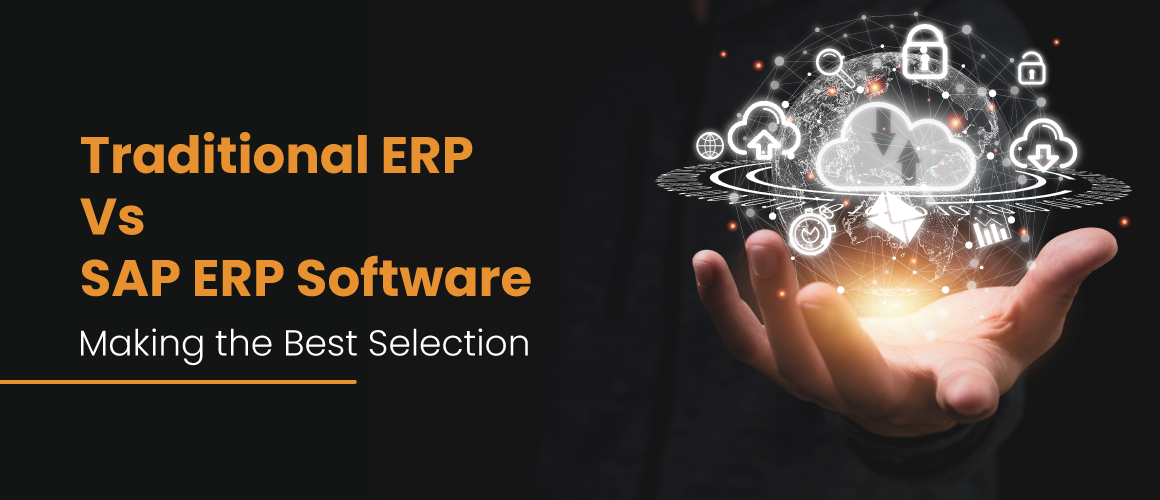
Modern SAP Cloud ERP is to achieve everything that traditional ERP does and beyond. SAP ERP centralises the data and communication to thorough integration of manufacturing modules. Let us show you the comparison between traditional ERP and SAP ERP in terms of features and performance.
| Sr. No. | Traditional ERP | SAP ERP |
| 1 | ERP is a software that manages the business process and streamlines operations. | SAP is a multinational company that sells ERP software solutions to organisations. |
| 2 | It is a centralised system. | Groups process into modules and interact with business aspects. |
| 3 | Termed as a super-set of a SAP software application. | SAP is the largest provider of ERP software. |
| 4 | ERP is a web-based application. | SAP ERP developers provide options according to the business requirements. |
| 5 | Focused on business growth. | SAP handles customers and business while developing SAP software. |
| 6 | NetSuite ERP, Scoro, AcTouch, are some of the examples of ERP. | SAP BI, SAP Enterprise Buyer Professional, SAP Internet Transaction Server, etc. are some of the examples of SAP ERP. |
SAP ERP Modules for ERP Software Pricing Guide
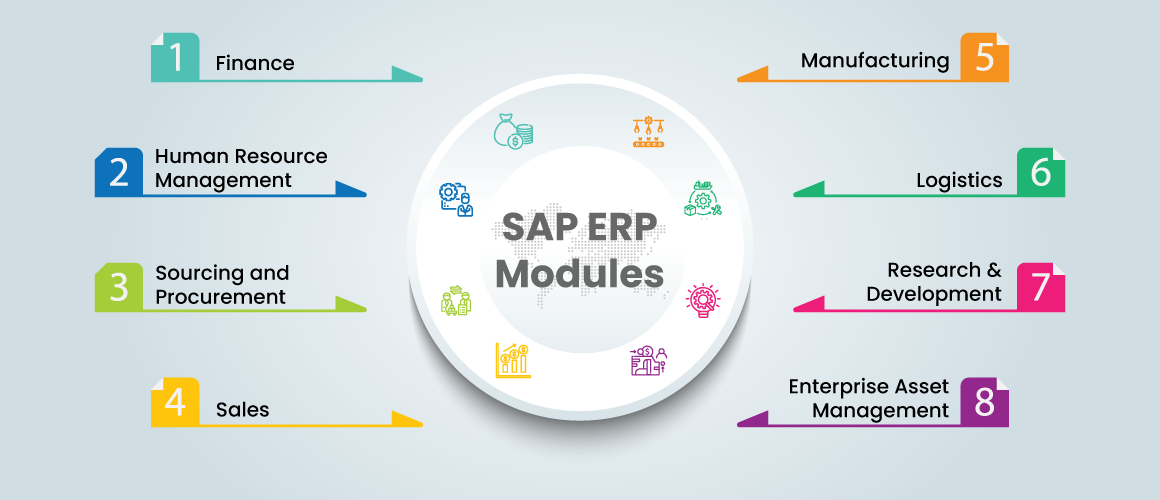
These elements are often offered with an add-on to a base ERP system and they definitely come with an additional cost. However, it is simple to add applications through ERP implementation with these configuration and customisation abilities of modern ERP.
ERP appliances focus on a variety of critical business processes where each trait has its unique tools for not to add a solution with redundant functionality. It is important to know which of these is more beneficial for your organisation. We tried to cover everything on our ERP software gricing guide so it becomes easy for you o understand.
Let us discuss ERP modules that are widely used.
Finance
Human Resource Management
Sourcing and Procurement
Sales
Manufacturing
Logistics
Research & Development
Enterprise Asset Management
The money and accounting module is the foundation of most ERP frameworks. As well as dealing with the overall record and robotizing key monetary undertakings, it assists organisations with following accounts payable (AP) and receivable (AR), close the books proficiently, produce monetary reports, conform to income acknowledgment guidelines, moderate monetary gamble, and that’s only the tip of the iceberg.
Most ERP frameworks incorporate a HR module that gives centre capacities like time and participation and finance. Core items, or even whole human capital management (HCM) suites, can interface with the ERP and convey more vigorous HR usefulness – everything from labour force investigation to worker experience of the executives.
The sourcing and procurement module assists organisations with getting the materials and administrations they need to make their merchandise – or the things they need to exchange. The module brings together and mechanises buying, including demands for statements, contract creation, and endorsements.
It can limit under buying and overbuying, further develop provider talks with AI-powered analytics, and even consistently associated with purchaser organisations.
The sales module monitors interchanges with possibilities and clients – and assists reps with utilising information driven bits of knowledge to expand deals and target leads with the right advancements and upsell open doors. It incorporates usefulness for the request-to-cash process, including request to the executives, contracts, charging, deals execution the board, and deals force support.
The assembling module is a vital preparation and execution part of ERP programming. It assists organisations with improving on complex assembling processes and guarantee creation is in accordance with request. This module regularly incorporates usefulness for material requirements planning (MRP), creation booking, fabricating execution, quality administration, and that’s only the tip of the iceberg.
One more key part of ERP frameworks, the inventory network module tracks the development of merchandise and supplies all through an association’s store network. The module gives devices to constant stock management, warehousing tasks, transportation, and strategies – and can assist with expanding production network perceivability and versatility.
Highlight rich ERP frameworks incorporate a R&D and designing module. This module gives apparatuses to item plan and advancement, product lifecycle management (PLM), product consistency, and that’s only the tip of the iceberg – so organisations can rapidly and cost-successfully make new developments.
Robust ERP frameworks can incorporate an EAM module – which assists resource concentrated organisations with limiting free time and keep their machines and hardware running at top effectiveness. This module incorporates usefulness for prescient upkeep, booking, resource activities and arranging, climate, environment, health and safety (EHS), and that’s only the tip of the iceberg.
Talk with our SAP Consultant to Digitally Transform your Business and to Achieve your Goals with Our ERP Solution.
ERP Pricing Models
In the case of ERP system price models, any cost considerations are a daunting challenge for the first time you purchase or upgrade from one platform to another. In order to ensure that it has an effective value since its application, consider a purchase that reflects a scale of enterprise.
Nevertheless, in today’s typical ERP there are two most important and accepted ERP modules, on-premise systems and SaaS model commonly referred to as cloud-based. However, considering these models, they have their own pros and cons.
ERP Licensing
ERP SaaS Subscription
For various reasons, small companies using local server ERP licences averaging $20k, in addition to foundation costs, can check out, since one way or the other any underlying buy expense can normally be recuperated rapidly, and once paid for, additional downstream personal monies can be opened up for use somewhere else.
This approach is generally effective for organisations that oversee and work their own little companion exchange networks like ERP managed point-of-sale systems (POS) for basic grocery stores.
For this situation, basic exchanges can pass straightforwardly from at least one of the store’s POS terminal(s) to a privately facilitated server, while staying away from any prerequisite to interact with some other bigger organisation. However, in this situation, the essential weakness of this ERP estimating model will be restricted development, since the undertaking should add more framework to stay aware of development past its underlying design. The underlying cost can likewise be a hindrance for private ventures with restricted free capital.
For moderate sized or enormous scope private/public organisations (utilising $20m as a regular starting expense benchmark), SaaS or cloud-based ERP execution offers an especially decent benefit. For this situation, a fair sized permit buying averaging $40k, in addition to framework, can permit an endeavour to recuperate it’s hard costs in just two business years, while basically leaving just month to month authorising expenses to manage going ahead.
This is especially favourable on the off chance that an undertaking needs to grow rapidly to oblige more asset handling sooner, for example, one could insight with a group of new agreements. This potential for development additionally makes SaaS membership ERP valuing models alluring to more modest organisations hoping to extend.
Connect with SAP Expert for Customised ERP Software Pricing Guide
How Much Does an ERP System Cost in UK? A Complete ERP Software Pricing Guide
As a rule, based ERP has lower costs than on-premise ERP on the grounds that there is no equipment that should be bought – and no costly in-house IT specialists that should be employed. The merchant handles the support and charges the client a yearly or month to month membership expense, generally founded on the quantity of clients.
While computing the profit from venture (ROI) and total cost of ownership (TCO) of another ERP execution, the underlying and continuous labour force costs are similarly basically as significant as the product choice and organisation costs. With cloud and cross breed choices, new factors should be assessed.
For instance, maintenance, computer capacity, downtime, recovery, security, privacy and other operational costs. Let us check the ERP software price comparison between small and large businesses.
Cost of ERP System for Small Business in UK
As a business the executives stage, the right ERP can bring an abundance of advantages to your small business planning, including:
- Lower stock costs through stock perceivability and tracking stock.
- Real-time tracking and analytics devices to help long haul arranging.
- Better business security with devoted insurance for on-premise/cloud servers.
- Unified client data that makes it simple to pull up chronicles and resolve issues.
- Quicker invoicing and regulatory work through process automation.
Cost of ERP for Enterprise in UK
Enterprises require grade ERP solutions. In looking for such a device, organisations with in excess of 501 employees and turnovers of above $250 million ought to be prepared to give out more than $1 million while buying such a solution.
Such ERP software includes NetSuite ERP, Syspro, SAP Business One, Oracle ERP, etc.
Factors That Affects ERP Software Price
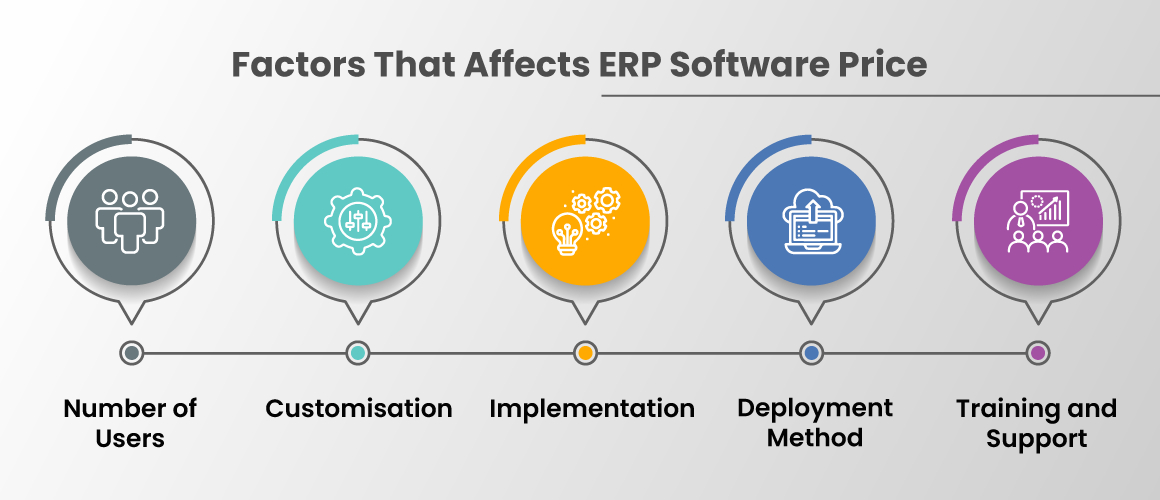
Everybody in the SME industry realises how much does ERP costs. What they cannot deny is that ERPs are notwithstanding being a robust venture are certainly not a one-time speculation. Additionally, there is no lucidity assuming the execution is effective.
Number of Users
Customisation
Implementation
Deployment Method
Training and Support
While deciding on an ERP program for your business, you want to assess the quantity of clients that will at first approach the product. Numerous ERP merchants charge on every client premise, meaning the more individuals who use it, the more costly it gets. You additionally need to represent the expense of adding new clients to your framework. How that cost could increase in the future as your organisation develops.
You’ll have to check with the particular ERP you’re keen on to check whether they charge per-client. This is significant particularly in the event that you have an enormous number of workers who will require access, as the costs will add up.
Customization in ERPs is less expensive. To that end tracking down a product/arrangement that satisfies all your quick necessities ought to be vital. Numerous merchants offer reconciliations with outsider additional items or the choice to remember explicit modules for expanded usefulness for your program. The expense of these extra capacities varies relying upon what you choose to incorporate and which merchant you go with for your base bundle. You ought to think about this component alongside ERP cost.
Most SMEs deal with a ton of issues in the execution of ERP as these frameworks are confounded for the most part implied for large organisations who are not new to the idea of digitization. On the off chance that you are executing ERP interestingly, you will probably require more committed specialised help than an organisation that has experience sending this kind of program.
There are advantages and disadvantages to both of these organisation techniques, with forthright instalment being one viewpoint that makes cloud arrangement more interesting to certain organisations. Assuming you’re more keen on an on-premise arrangement however, you ought to recall that albeit forthright expenses are higher.
Organisations with cloud ERP end up paying a great cloud ERP pricing as a result of the additional items/customization without knowing whether the framework has been effectively executed or not.
Training and customer support are two fundamental parts to consider while assessing the expense of an ERP arrangement and how well a program will function with your organisation’s requirements. Overall, 15-20% of a product spending plan, making it a major lump of your cost thought with regards to working out ERP cost.
A few merchants offer their own preparation choices on location and by means of online instructional exercise recordings and classes. Be that as it may, this help could possibly be remembered for your general programming cost contingent upon the merchant you go with.
How to Choose a Right ERP Pricing Model – a Complete ERP Pricing Guide
Regardless of whether you as of now have approval to put resources into another ERP software, you should set your financial plan and legitimise the expenses. While not these parts will apply to all executions, they ought to be in every way viewed as for you to conclude the ERP selection process for your business. Here are a portion of the vital parts in arranging the expense of ERP:
- ERP software licence expenses
- Additional servers and hardware
- Data change and shifting to new ERP
- Customization if essential
- Testing
- Training
- Vendor support post installation
These are the most substantial expenses to remember for your financial plan however you additionally need to think ahead to monetary banana skins and account for possibilities. We will go into the secret costs somewhat further on.
Let’s Share your Business Need & Our SAP Expert will Call you Back.

Selecting ERP Features as Per Business Needs
Any cutting edge ERP framework will have a not insignificant rundown of capacities in light of the business they serve and the modules they offer. However, there are 10 major elements that all undertaking asset the board frameworks ought to have:
Common data: Centralised data and single variant of reality – giving predictable, shared information and a cross-useful perspective on the organisation.
Embedded Analytics: Built-in investigation, self-administration BI, detailing, and consistency apparatuses that can convey savvy knowledge for any region of the business.
Data perception: Visual show of key data with dashboards, KPIs, and point-and-snap examination to aid fast and informed navigation.
Automation: Automation of monotonous errands as well as cutting edge RPA controlled by AI and AI.
UI/UX: Similar look and feel across modules – as well as simple to-utilise arrangement and personalisation apparatuses for processes.
Integration: Seamless mix of business cycles and work processes – as well as open and simple reconciliation with other programming arrangements and information sources, including from outsiders.
New techs: Support for AI and AI, computerised colleagues, the IoT, RPA, security and protection, and portable.
Innovation stage: A quick, demonstrated, and stable innovation stack for this drawn out speculation – including a low-code/no-code stage.
Deployment: Cloud, on-reason, or crossover.
Connect with SAP Expert for Customised ERP Software Pricing Guide
How Much Does ERP Implementation Cost? – Cost of ERP Implementation and Installation
Introducing the actual product will shift from one supplier to another and from one venture to another, particularly assuming you are going with an on-premise model however you don’t yet have adequate framework to help it. To completely comprehend establishment costs, you should review your ongoing foundation to check whether it compares facilitating the product and afterward ascertain the expenses of extension.
Ongoing Costs to Consider
The most well-known underrated or outright cost of ERP implementation are staff training, unexpected customization and data change. You can moderate a large number of the ‘covered up expenses’ by expecting the additional work, preparing, and includes that your new ERP requires. In any case, there are many costs that show up later, after execution, that you want to make arrangements for.
This, thus, can mean retraining as well, meaning additional time and more assets you hadn’t anticipated. Notwithstanding, there are frequently covered up rewards to execution that will neutralise the expenses, and having around 10% possibility spending plan incorporated into your ROI projections will place you in an advantageous position for any unexpected consumption.
7 Smart Cost Strategies for ERP Selection
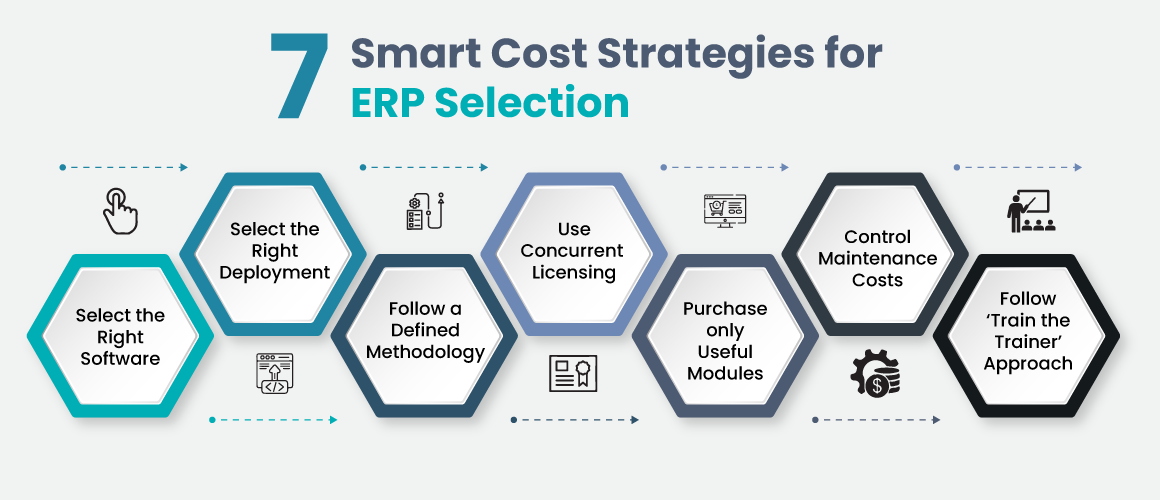
By covering the ERP software pricing guide we also covered these 7 smart cost strategy that will help small business and enterprises to select the right ERP software for their business as per the requirements.
Select the Right Software
- How much time do you spend on manual processes that are labor intensive?
- How easy is to retrieve the information you need from your systems?
- How flexible are your businesses processes?
- Do you need a system(s) that works in line with your business or is the business happy to work in line with the system(s)?
- Does your business need a system that can do most tasks, or are several systems necessary to complete your processes exactly as you require them?
Select the Right Deployment
Follow a Defined Methodology
Use Concurrent Licensing
Purchase only Useful Modules
Control Maintenance Costs
Follow ‘Train the Trainer’ Approach
You should begin with analyzing what you really need in an ERP software solution. Whatever solution your business decides to go for, they key to success lies in choosing a system based on your specific requirements, not concentrating an all the functionality you may not even utilize.
Below are a few points to consider when making the choice, which it’s important to remember will be the foundation of your business for the next three-seven years:
If you are a small to mid-sized company with limited resources and budget, then possibly you’ll want a fully integrated ERP system that is flexible enough with functionalities to adapt the ever-changing needs of your business. Such a software selection will improve productivity at a much lower cost.
Read this to find out more why need you an ERP solution.
Deployment of an ERP solution for your business will depend on many reasons but you need to consider the one focuses on cutting the costs down. There is software available for both on-premise and cloud.
The difference between both types is that you pay for an on-premise ERP software along with an additional cost of hardware setup and maintenance whereas cloud is generally provided on software-as-a-service (SaaS) basis for a fixed monthly fee.
Read our case study on Saas Based Remote Inventory Mgmt. System
An experienced ERP vendor will understand your business requirements and propose a suitable implementation methodology that has already been successfully used. Using an already defined and structured implementation process reduces risk and wastage of time in monitoring and controlling the project especially during the execution phase.
Following this strategy also helps in preventing the project from stalling unnecessarily by paying attention to the most important steps.
Read this to find how a UK based wholesale distributor benefitted from an ERP solution.
Opt for limited licenses. User licenses for ERP software are normally priced on concurrent basis, meaning, you don’t need to pay for all the users but only for the ones that use the system simultaneously. This way you can scale down the costs by only paying for the users who log on at the same time.
Getting modules that aren’t useful to your business at all or maybe in little ways can impact the overall pricing. For example, your business will need an advanced e-commerce module to meet your needs but you are not yet ready to use those features. Wait until you are ready and add it to your agreement at that time.
Software maintenance basically includes keeping the system updated with important enhancements and zero bugs. Not keeping your ERP system updated or letting the issues unresolved for a longer time can be expensive. You need to get a service agreement from your ERP vendor who would provide timely upgrades and updates that would, in the long run, save you time and money.
Training every user of the system can increase total costs. Instead, get a few of your key employees trained and allocate them the duty of training other users. This way those key employees can get a better and deeper understanding of the software, save you extra training costs and reduce future reliance on your ERP provider.
Did you know that high-growth SMEs running ERPs have 11% lower operational costs?
Know More How Much does SAP Business One Implementation Cost?
Wrap Up – ERP Software Pricing Guide
At this point, you probably found out about how to gauge ERP establishment costs. Different variables impact the general expense of the ERP framework. For a sensible gauge, you might put ERP execution and support costs at one to two percent of the organisation’s yearly income.
By knowing this ERP software pricing guide you will got to know that the right way to effective ERP execution is understanding your organisation’s squeezing need for various ERP modules. Ensure you just pick modules that you most certainly require.
Silver Touch Technologies better understands where your industry’s future is headed and will provide a suitable software solution that best fits your requirement. With ERP solutions we help SMEs to cut costs, lower overheads and drive profits.
Contact us today on +44 – (0) 203-872-5140 or e-mail at info@silvertouchtech.co.uk and get a free SAP Business One demo today!

